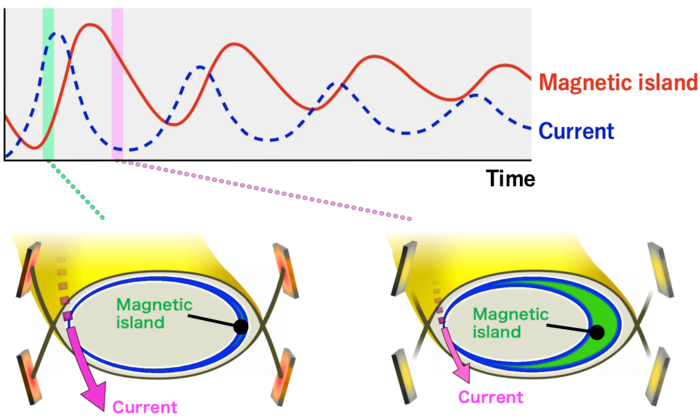To control the forces that enable the Sun to generate significant clean energy on Earth, scientists heat fuel to an extremely high temperature causing atoms to melt into electrons and nuclei to produce a hot, gaseous soup referred to as plasma.
 Increased current enhances the magnetic island. In turn, electric resistivity increases, which reduces the current. Eventually, the magnetic island shrinks, which leads to a reduction of the electric receptivity and an increase in the current. The relation between the magnetic island and the current is analogous to that between predator and prey. Image Credit: National Institute for Fusion Science.
Increased current enhances the magnetic island. In turn, electric resistivity increases, which reduces the current. Eventually, the magnetic island shrinks, which leads to a reduction of the electric receptivity and an increase in the current. The relation between the magnetic island and the current is analogous to that between predator and prey. Image Credit: National Institute for Fusion Science.
The plasma, which is approximately 20 times the temperature of the Sun’s core at 200 million °C, is capable of tearing through any material on Earth, so it has to be limited by magnetic fields — but it can only be regulated for short periods. Scientists have been able to apply this control for several years, without comprehending the exact physics of how it functions.
Currently, in a first step to extended control, scientists at Japan’s National Institute for Fusion Science have discovered that the fundamental mechanism can mirror the implausible biological predator-prey model.
Their article has been published online on February 1, ahead of publication in the journal Physical Review Letters.
“It is necessary to reduce the plasma heat load—especially at the divertor, where the heat load becomes most significant—while maintaining the core plasma performance,” said paper author Tatsuya Kobayashi, National Institute for Fusion Science in the National Institutes of Natural Sciences and The Graduate School of Advanced Studies, explaining that the divertor serves as the LHD’s waste removal tool throughout operation.
To lessen the heat load, the scientists can trigger detachment plasma by forcing the plasma’s components to reunite and disperse energy in the form of light in front of the LHD’s divertor.
In the present experiments, the detachment plasma is produced by applying an external magnetic field perturbation with supplementary magnetic coils. By doing so, a magnetic field structure embedded in the main plasma body, called the magnetic island, appears, enhancing the peripheral radiation energy losses and pushing the plasma to the detachment state.
Tatsuya Kobayashi, Study Author, National Institute for Fusion Science
“While the operation condition has been experimentally determined, the background physics was not fully understood yet,” Tatsuya Kobayashi added.
Through additional analysis, the scientists discovered that the magnetic island and the point at which the plasma shifts between detachment and attachment phases ocillated in a self-sustained ripple. The plasma current’s parameters at the divertor directly impacted the width of the magnetic island, which then factored into the altering of the plasma parameters.
“We found a competition between the magnetic island and a nearby localized plasma current flow that can be described by the predator-prey model,” Kobayashi said, describing that the model draws on how the population of a predator relies on the population of its prey and vice versa. The relationship can be graphed as two intersecting lines rising and dipping just marginally out of sync.
The magnetic island is essential to reducing the plasma heat load, so the competitive oscillation between the magnetic island and the plasma current is also reflected in the plasma heat load on the divertor.
Tatsuya Kobayashi, Study Author, National Institute for Fusion Science
The scientists employed the predator-prey model between the magnetic island width and plasma parameters to illustrate the divertor oscillation and effectively replicated the observations of the experiment.
Through this work, we significantly deepened the understanding of the background physics of the divertor detachment operation. Next, we plan to develop a stable and efficient detachment scenario, utilizing the background physics knowledge obtained through this work, to realize the magnetic plasma fusion plant.
Tatsuya Kobayashi, Study Author, National Institute for Fusion Science
Other contributors include M. Kobayashi, Y. Naurshima, Y. Suzuki, K. Y. Watanabe, K. Mukai, and Y. Hayashi, all with the National Institute for Fusion Science in the National Institutes of Natural Sciences.
Kobayashi, Narushima, Suzuki, and Mukai are also affiliated with The Graduate University for Advanced Studies. Suzuki is also with the Graduate School of Advanced Science and Engineering at Hiroshima University. Watanabe is also with the Nagoya University Graduate School of Engineering.
This research was partly supported by the Japan Society for the Promotion of Science.
Journal Reference:
Kobayashi, T., et al. (2022) Self-Sustained Divertor Oscillation Driven by Magnetic Island Dynamics in Torus Plasma. Physical Review Letters. doi.org/10.1103/PhysRevLett.128.085001.